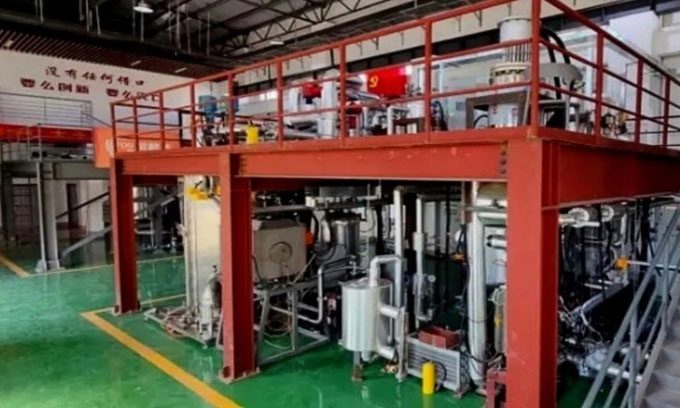Chinese researchers are developing a 1.5-megawatt reactor that stands as tall as a 20-story building when extended, enabling round trips between Earth and Mars.
This collaborative project, involving over 10 research institutes and universities across China, is making significant strides toward interplanetary travel with the development of nuclear fission technology, which allows for large-scale exploration of Mars. In a paper published in the Scientia Sinica Technologica journal of the Chinese Academy of Sciences, the research team reported that their prototype lithium-cooled reactor system has successfully passed several initial ground tests, as reported by Sun on March 19.

Testing prototype of China’s lithium-cooled reactor. (Photo: Chinese Academy of Sciences)
The test results confirm several key technological solutions that Chinese scientists and engineers have invented to miniaturize a megawatt-class reactor, making it seven times more powerful than NASA’s systems, to an unprecedented size. When fully deployed in space, the 1.5-megawatt reactor, including its cooling system, could reach the height of a 20-story building. However, on the ground, it can fold into a container weighing less than 8 tons.
This design allows for easy placement and launch of the reactor on rockets, according to the research team led by scientist Wu Yican at the Academy. The reactor can also maintain stable operation in the harsh environment of space for extended periods. According to the paper, the high-power energy source will make round trips feasible for both crewed missions and cargo flights, paving the way for China’s large-scale lunar and Mars exploration efforts.
Some scientists estimate that a nuclear-powered spacecraft could complete the round trip between Earth and Mars in just three months. Currently, the scientific community agrees that this technology is essential for interplanetary missions. In contrast, spacecraft relying on fossil fuels, like the Starship system developed by the American company SpaceX, may require at least seven months to reach Mars, according to various calculations. The Starship rocket is central to NASA’s plans to land astronauts on the Moon by the end of this decade, as well as SpaceX CEO Elon Musk’s ambitions for Mars colonization. However, a one-way trip to the Red Planet will necessitate a massive life support system.
NASA’s Artemis program plans to send a nuclear reactor to the Moon and use similar technology to build spacecraft for Mars colonization. The European Union has initiated three projects aimed at developing nuclear-related space technology. Russia is also reviving its nuclear-powered spacecraft program dating back to the Cold War. According to Wu’s research team, Russia is making the fastest progress in researching and developing several key technologies in the field, including nuclear fuel in space.
Researchers state that China’s reactor will reach temperatures of 1,276 degrees Celsius through the fission of uranium fuel, far exceeding the operating temperatures of most commercial nuclear power plants. This extreme heat will vaporize inert elements like helium and xenon into gas, facilitating power generation. The chain reaction produces fast neutrons, allowing for efficient and continuous electricity generation for at least 10 years. By using liquid lithium, the research team can make the reactor smaller due to the high thermal conductivity and light weight of this element.
Typically, heat exchange equipment and radiation shielding take up significant space in reactor designs, but Wu and his colleagues report that they have developed technology that combines both components into one. The reactor’s heat exchange device, made from tungsten alloy, can efficiently exchange heat while simultaneously blocking harmful radiation. Other new technologies include high-temperature erosion-resistant materials. At this stage, the heat source for the reactor prototype is an external power supply. The research team’s plan is to add nuclear fuel rods to allow the reactor to operate fully in the subsequent testing phases.
The tests preliminarily demonstrate the feasibility of combining a lithium-based cooling system with a Brayton generator, which was developed in the 19th century in the form of a piston engine and is widely used in powered space flight. A major focus that needs further research and development is the reactor’s safety during launch and operation. A mandatory requirement is that there is no risk of a nuclear explosion even if the reactor falls back to Earth. The project team also plans to apply artificial intelligence for the long-term autonomous operation of the reactor in space, utilizing diagnostic and troubleshooting technologies.


















































